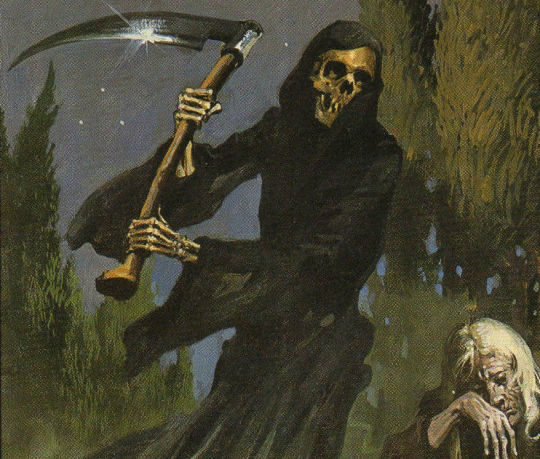Text
Important Kemetic Terminology
Em Hotep, everyone. Today I will talk about some important terminology used in Kemetic circles. I may or may not do a part two at a later date, but this is just the basics for now!
Sayings
Em Hotep - means "come in peace". Very common in Kemetic circles
Anudj har - means "hail to" (e.x. anudj har Ra means "hail to Ra")
Heru nofer - means "good day"
Religious Terms
Ma'at - when not referring to the deity, refers to the fundamental order of the universe
I/s/f/e/t - the opposite of Ma'at, pure chaos. Often censored to avoid giving it power
A/p/e/p - the giant snake that opposes Ra when he travels through the Duat. His name is censored to prevent giving him the power he desires
Heka - "magic", but not as we think of it. Heka is the magic of speech, as words are often louder than actions, but are actually the same thing. Thought and deed are united in the magic of heka
The Duat - the afterlife, ruled over by Wasir. To arrive, you must travel through the twelve kingdoms/hours of the night, the same journey Ra takes every night.
Conception of the Soul - this is a longer idea, and thus I will cover it in a separate post. There are eight different parts of the soul
Khet the physical body
Sah the spiritual body
Ren the name and identity
Ba the personality
Ka the double
Ib the heart
Shut or sheut the shadow
Sekhem the power and form
Important Texts
Book of the Dead - quite possibly the most important, and also called "Book of Coming Forth by Day" or "Book of Emerging Forth into the Light", the Book of the Dead is filled with spells and rituals that were used to assist a deceased person's body on their journey into the Duat
The Coffin Texts - spells and rituals to assist a deceased into the Duat. These were written on coffins when the deceased were buried. The Coffin Texts were later copied into the Book of the Dead
The Pyramid Texts - the oldest of the funerary texts, written on the underground pyramid walls. The Pyramid Texts were used for pharaohs only, and were quite similar to the spells and rituals of the Coffin Texts and Book of the Dead
The 42 Negative Confessions - a list of "sins" (for lack of a better term) that are used during the Weighing of the Heart Ceremony.
As I said before, I will most likely do more parts explaining more important aspects of Kemetic religion. A list of what I have planned is as follows:
The 42 Negative Confessions.
A more in-depth look at the afterlife, specifically the twelve kingdoms of the night and the Weighing of the Heart ceremony.
The Conception of the Soul
A history of i/s/f/e/t and a/p/e/p
If there's anything you'd like me to cover, feel free to ask and I'll definitely do so!
591 notes
·
View notes
Text
"Do not eat bread while another stands by, without extending your hand to him. There is always bread: people do not last for ever."
Fortieth maxim of "The Teachings of Ani" from "Writings from Ancient Egypt" by Toby Wilkinson
3K notes
·
View notes
Text
The Man In Black
After many questions and a few requests, I think it’s time to make a longer post about this.
An enigmatic figure has floated around in witch lore for a very long time. A particular spike in his appearance comes into place during the Early Modern Period. A tall man, comely and swathed in black, adorned with either the horns of a goat or that of a buck, approaches men and women alike to offer them a new life. If they decline, they will go about their life as if it was an illusion. If they accept, they will be granted gifts and wealth (of all kinds) in exchange for loyalty to him.
Throughout the centuries, he’s acquired many different names. He’s been called Old Nick, Old Scratch, The Black Goat, Akerbeltz, Black Donald, The Dark Man, and countless other names. Of course, they’ve all been summed up rather quickly with the word ‘Devil’. And is he?
Yes and no.
The Man in Black is not to be separated from the Christian Devil, but that is not his sum total. He represents much more than that and is an extraordinarily complex figure; so complex that his nature cannot be completely known (a trait that I’ll see to in a bit). He is Lucifer, the Usurper, the Light Bringer, the Torch Bearer, and the Opener of Eyes.
The Man in Black is intimately connected to the topics of the dead, the underworld, fertility, sexuality, and magic. Though the intermingling of life and death might seem befuddling at first, it is important to understand that this is the truest representation of the wilderness. Thus, in total, the Dark Man is, above all, a spirit/deity that represents the Wilderness found both inside humans and outside of them.
He also represents ‘The Great Other’. Where there is order, he is Chaos. This too can be said for all things natural. In a world where we live between giant, rectangular towers, he is the storm that makes them shiver. He is the flaw in the bricks. He is the tree that crashes into them.
Beyond that, he is the concepts that have been shunned by polite society. Most importantly, sexuality and aggression. These primal instincts are intertwined and deeply misunderstood. Sexuality does not always mean lewdness. Aggression does not always mean butchery. Sexuality is the force through which life is animated. It is the conjoining and drinking of souls. Aggression is competitiveness. It is a will to survive and thrive.
In these, we find the origin of him being Satan. Satan is the Lord of Sin, the Liar, and the Roisterer. The Man in Black drinks deeply of Earthly pleasures. He cannot be predictable, for that would make him orderly, where he is chaos. He excites primal passions, of both lust and fury.
His Chthonic associations don’t help with this. Beasts that are usually thought to be messengers and walkers-between-worlds are his symbols, like crows, flies, snakes, toads, foxes, deer, and most importantly, goats. This Underworld association also deals with his link to primal emotions and concepts we tend to ‘push deep down’ for the lack of a better term. Death is one of them. This too deals much with his associations with Chaos. Hell is simply the Underworld. Where the Underworld is Chaos, the Heavens are Order. Earth is the marriage of the two. Where there is civilization, there is also wilderness.
He could be considered a trickster, but more appropriately, he is the Trickster. He isn’t an other, he is the Other. Where in Christian mythos, God created Order, the Dark Man usurps control and creates Chaos
His title as the ‘Witch-father” denotes his fondness for, and interest given to, witches. Witches, even separated from the Devil, always have represented the wilderness, or the most wild, primal, and beastly parts of mankind. Naturally, they would be joined with the very spirit/deity that is the embodiment of these qualities. The Man in Black is the embodiment of the thing that witches hold precious, and when they are joined, he teaches and guides them to be the best witches they can be. Many view this as servitude, and while it is true that many witches hold allegiance to the one who pulled them onto the path, it isn’t necessarily true that they are his unwilling servants. The ones who do favors for him are also the ones who are quite affectionate towards him. He isn’t a slave-driver with a whip. Instead, he represents the man who steals the whip from his master’s hand and gains freedom.
Similarly, witches are often people in folklore who have gained powers not intended by God to override His own Divine Will. They are selfish and they change the world to suit their means, and for some, that meant bringing kings and queens to their knees. As Lucifer coveted the Throne of Heaven, so these witches would no longer be subservient.
Since ancient times, people have looked to find the wilderness in horned male spirits and deities. They pray to them when they hunt, they pray to them when they wish to have children, they pray to them when they want connection to the wild. Magic practitioners and religious priests wore horns atop their heads as symbols of spiritual importance. Horns were thought to bestow the ability to see, hear, and interact with the spirits. They were, in essence, both crown and key. They were thought to bestow strength and a will to survive, but also a sensitivity to things beyond the perception of most. We find these qualities in the Man in Black.
Commonly, he is portrayed with a flame between his two horns. This flame is called the Cunning Fire. Those witches who he has created and initiated are lit by his own flame. He passes the Fire Between the Horns to his witches, and they too have power over the world as he does. How does he do this?
He is known as the one who swallows what is and spits out what will be. He eats away the parts of a person that stops them from traversing the witch path. This common theme, even outside of witchcraft, is found in folklore of him, especially in the American South. He puts them through a test of sorts, where they are made to suffer internal and external turmoil. If they pass, they leave changed, new, and somehow improved. For witches, he gives them fire, and in doing so, gives them power. If they don’t pass, they either try to walk away as unscathed as they can, or they leave broken.
In some witch myths, he has drawn his initiates to the woods and attacked them. If they survived, he rewarded them. Still, this happens spectrally when some fly. Some account for being attacked, torn apart, and put back together.
He didn’t always create the witches, either. Some of them were waiting to have latent skills awoken, and during his testing phase, he spurred them. Those witches who were said to have power asleep inside them would go through this to awaken their talents.
Witches of the past, and even many in the present, initiate under him. During this process, many people believe that a witch is selling her soul for powers and a new life. While it is true that a ‘witch’s sixpence’ is required when asking, it is not the soul that is bargained off (though I’m sure he wouldn’t refuse it if offered). Instead, the witch is bound to the path and the spirits of that path. They become a part of one another. Their soul, though their own, is part of a larger whole then. The witches before then and the spirits who guide the tradition, in this case the Dark Man, become a part of the initiate and vice versa.
He is to be considered the Master of the Hidden Art. Some people interpret this as widely magic in general, while others feel that it is specific to witchcraft. He is often called the First Sorcerer, the Shapeshifter, the Wanderer, the Trickster, and the Horned One. He stole the Fire (the hidden knowledge), the light, from Heaven and gave it to humankind. This theme has repeated throughout history, of a wild God stealing fire and giving it to the world. In this case, that fire is magic and forbidden knowledge. He is the Light-bringer and is called Lucifer. The fallen angels, too, known in some mythos as faeries and in others as gods, impart their Divine Spark to humans as well.
He appears as many things. He does not have one form. He is the great buck, standing tall with a full set of antlers. He is the black wolf that eats it. He is the goat with great horns. He is the fox that enters the peaceful henhouse and eats to his content. He is both hunter and prey, for the two are sometimes one and the same. He is the man wearing a black suit, handsome and tall.
The wild places are his domain. Not just in the woods does he dwell, but back alleys and bus stops late at night. Crossroads lit by moonlight but shaded by fog are his home too. He walks among beasts and humans. He walks the woods quietly and slyly. He walks among the people at midnight in the city.
The Man in Black is an enigma, even to those who know him. He is Chaos, and therefore is eternally shifting shapes. As nature changes over the span of 100 years, so does he change with the world. His nature is to never fully be known, but truly be felt. He is, perhaps above all, feeling. Fear, aggression, lust, excitement, bliss, etc. These are his calling cards.
Working with him isn’t something that someone else usually teaches. Someone might teach you how to call him, but they can’t tell you how to work with him. Like I said, he ever changes. His way of working with each is different.
How would you call him?
How was the Devil called in folklore?
Almost always at a crossroads or in the woods, but as I stated before, these are not his only domains.
Alcohol, money, black hen feathers, antlers and horns, bones, poisonous plants, etc are all things that will draw him close.
But the most important ingredient is feeling. Whatever feeling you have while calling him has to be felt fully. Envelop yourself in it. Fear, bliss, or whatever it is, must be sat in. The reek of it will call him.
He is known to appeal to feelings and senses when he arrives. He is not only drawn by them, but he is an embodiment them. He is inside the fear and the bliss. Through that, a connection can come. That connection can be so vivid and profound that it is often found to be either extraordinarily comforting or deeply unsettling. It is to touch the other half.
If no other spirit or deity will remind you that working with him is a relationship, he will. Everything has a price on it, and that goes for his end too. Whatever favor or task performed, he will grant favors in kind. It is always important to remember that he is a trickster, however. His favors are always repaid, but not always in the way you’d expect them to be.
Witches who walk a traditional path will run into him, be it through the pages of a book, a fleeting thought, or a full-blown ritual. It is impossible to avoid him when practicing folkloric craft. He is not, however, required to be worked with. He is beloved by many witches, and will welcome more into his fold, but it is not required that a witch becomes one of his. Instead, it is always important to remember what he stands for as a champion of witches and what kind of qualities he puts forth as a sorcerous spirit. He is a reminder that, in the traditional and folkloric ways, a witch is a wild being; truly, both hunter and hunted, both crown and key, both king and usurper, both natural and supernatural.
2K notes
·
View notes
Text
Seth: Phallus of Set, God of Sexuality
“I am Horus, my father Osiris, who seizes
the phallus of Seth for you with his hand”
Finger and phallus seem to be interchangeable. We surmise that it can be said that the finger of Seth lights up the eye of Horus, because it is the phallus of Seth, that is thought of. Seth’s phallus emits fire. Not only the open conflict, the homosexual play too is from the beginning of a violent nature. He who looses the finger or seizes the phallus, puts an end to the ascendancy of Seth. Elsewhere there is mention of the theft of seed. At the same time, it must be admitted that this attack on the part of Seth ultimately led to the appearance of the eye of Horus. Thus one can say: the finger or the phallus causes the eye to see or illuminates it. The familiar hieroglyph of the wd3t might be an eye overflowing with moisture or light.
In the sacrificial liturgies we find the longing for and the belief in the restoration of peace and harmony. The lector-priest who says he is Thoth, recalls discordance that was overcome:
“The distress that causes confusion, has been driven away, and all that gods in harmony.
I have given Horus his eye, placed the wd3t-eye in the correct position.
I have given Seth his testicles, so that the two lords content through the work of my hands.”
In the “ritual of Amenophis I” the offerings made are called “eyes” and “testicles”:
“come to these offerings …
I know the sky, I know the earth, I know Horus, I know Seth. Horus is appeased with his eyes, Seth is appeased with his testicles.
I am Thoth, who reconciles the gods, who makes the offerings in their correct form.”
Horus, and no explicit mention is made of the testicles. Now the wd3t-eye in itself presupposes an integration of contrasts and a certain harmony between Horus and Seth. Such an integration, however, implies that Seth the privateer and outsider, shall be of service to others. Offerings the testicles to Seth is apparently a risky business. There seems to be some hazard attached to establishing a harmony in which Seth is so positively concerned that the testicles are independently stressed besides the eye.
Apparently it is no historical accident that the symbols “eye” and “testicles”, light and sexuality, are paired in this way in Egypt. Elsewhere too, where no historical link whatever with the Egyptian religion can be pointed out, light and sexuality are opposed to each other. According to a Tibetan myth mankind had originally no sexual desires. They bore the light within themselves and were radiant. When the sexual instinct awoke, the sexual organs originated, but the light in man was extinguished and Sun and Moon appeared in the sky. A Tibetan monk added that originally mankind propagated themselves throught contemplation and light and that physical contact and sexual union was a phenomenon of degeneration.
We are strucky by the fact that in Egyptian mythology also the light has diminished, the eye of Horus has become small owing to the homosexual relations of Horus and Seth, and that here too the light is hidden in the semen. The moon comes forth out of Seth, who has devoured the seed of Horus. Naturally there are great differences between Tibetan and the Egyptian religion. An Egyptian priest would not judge sexuality to be a phenomenon of degeneration.
Even that sexuality, which in its symbol of the testicles of Seth is shown to be by no means confined to heterosexuality, does not remain in conflict with the light. Horus and Seth light and sexuality, are reconciled. In the sacrifice eye and testicles, light and semen can be joined. Indeed, according to the Egyptian concept of life they must be joined. Such is also evident from passages not taken from sacrifical texts.
“Aten: Thy rays penetrate into the ocean. Thou dost cause the seed in women to take shape, and make moisture into men.“
[…] the testicles of Seth were not regarded as a symbol of political power only. The impotent man can turn to Seth in his distress.
It is not by chance that dead man who desires sexual pleasure in the hereafter, identifies himself successively with Baba, the god of the phallus in erection, and with Seth:
“My phallus is Baba. I am Seth.“
Kristensen called the testicles of Seth a fertility symbol. Now it is worth while to examine the nature of this fertility symbolised by the testicles of Seth. It would seem to us that everything is called fertility in earlier works of religious history-and that is a good deal-is not summarised in the symbol of the testicles.
Van der Leeuw’s view, that it was thought fertility would cease because if the mutilation of Seth, is not supported by texts. An interesting remark of Anthes, "the destruction of the testicles of Seth may recall the sterility of the desert”, also fails to find comfirmation in the texts.
More recently, however, Zandee has tried to show by means of a great number of texts that Seth was a fertility god. Yet the texts he adduces prove no more that Seth has greath strenght, and particularly great sexual strenght. It is true the rain, which Seth was lord of, promotes the growth of plants. Yet in Egypt vegetation and the fertility of the soil is not dependt on rain, but on the inundation of the Nile. Seth is called a bull, but in this comparison he is not a paragon of fertility.
[…] We hesitate to call Seth a god of fertility, for, precisely, his boundless energy is not productive. He is the voluptuary who is tricked, for his sexual power is taken from him. One might object that the testicles are offered to him. The sacrifice of the testicles to Seth, however, never takes place separately, as far as can be ascertained, but in conjunction, with the eye of Horus. This means that eye and testicles are sacrificed to a double-god. […] A man who is ill or dead may, in extreme need, have recourse to Seth, and identify himself with him, but Seth is not the ideal of fertility. Even lacking the support of the notorious unpublished erotic papyrus of Turin, it must be garanted in a general way to Yoyotte, who gives various examples, that Egyptian eroticism is not summed up in fertility symbolism. The points mentioned above, Seth’s homosexuality and the fact that he was credited with practices of abortion, demonstate that Seth is a god of sexuality which is not canalised into fertility. The aspect of sexual life which finds expression in marriage is not connected with Seth but with other gods.
Seth’s sexuality cannot be equated with fertility, yet we must take heed not to mark it down as homosexuality only.
He experiences heterosexual desire towards the goddes, Isis. His feelings are not returned. He is so badly deceived by Isis, that he complains in tears to Re, perhaps this passage cannot be held to constitute convincing evidence of heterosexuality as an alternative choice. The sexuality of Seth is irregular. The Sethian man is beloved of women “through the greatness of his loving them”.
Seth: God of Confusion
by. H. te Velde; pg excerpt (50, 51, 52, 54, 55)
Keep reading
131 notes
·
View notes
Text
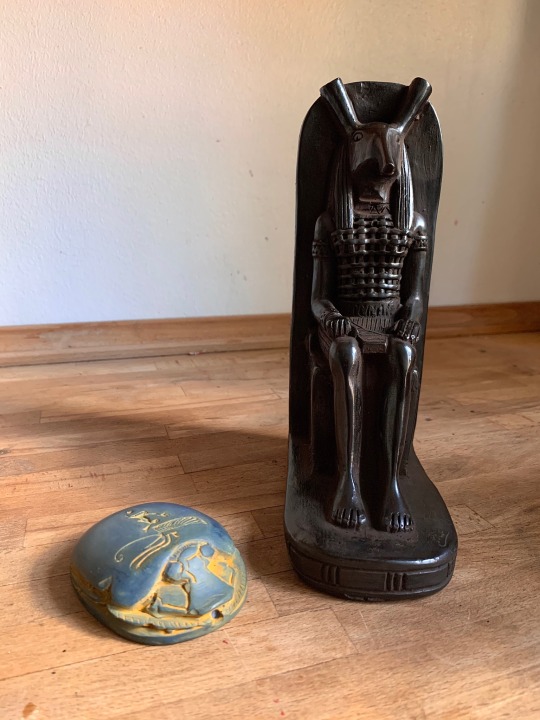

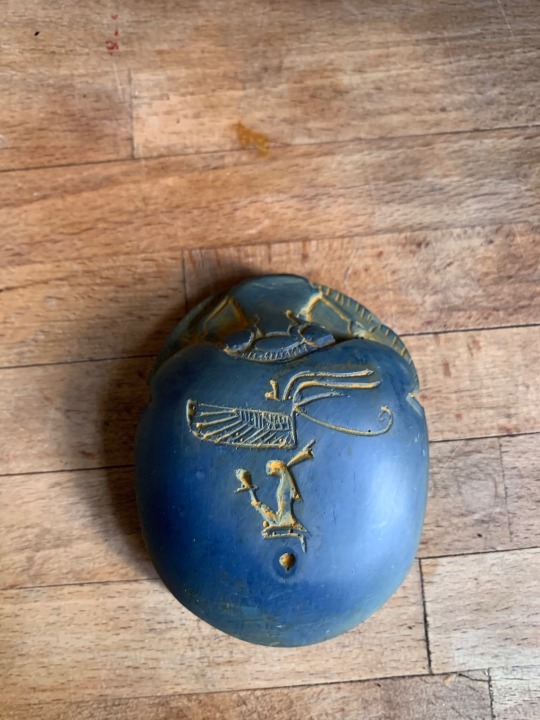

MY STATUE IS HERE!!!
I really fucking scored on this one, you guys; not only is the motive exactly how I wanted (black and seated) but it’s also all the way from Cairo, Egypt.
It’s handmade by an Egyptian seller, who was incredibly nice and easy to keep in touch with through the whole process. They even sent me an extra item, this gorgeous scarab, that I didn’t order ♡
Dua Sutekh
58 notes
·
View notes
Text
Seth is the essential enemy. He is the personification of blind force and unregulated violence. Another Pyramid Text alludes to a legend that he burst forth from his mother’s womb: ”You whom the pregnant goddess brought forth when you clove the night in twain - you are invested in the form of Seth, who broke out in violence.”
- Myth and Symbol in Ancient Egypt, R.T Rundle Clark
23 notes
·
View notes
Text
The Sites of Seth
A study of different places concerning the god Seth
The god Seth is usually represented as a canid with a dropped snout and straight ears standing either seated or recumbent.

The anthropomorphic figure with the head of Sethian canide is rarely found in the early dynasties. Historically, the first representation of the Seth animal appears during the period denominated Naqada I at the Predynastic cemetery at El Mahasna (Ayrton&Loat 1911, p.31).
According to Petrie classification of the ceramic remains, the Sethian animal is only found in the SD 30-39, named C, regarding white figures over dark red background (Graff 2009, p.15). These Sethian images appear in a context closely related to the mountains and vegetation, specially the sedges, which fits very well with the hieroglyphs associated with one of the writings of his name (swty) which means ‘he of the sedge’(Kemp 2006, p. 71). The xAst mountains (Gardiner sign N25) is a determinative related to the desert, which is a common land of Seth as we will see.

The first evidence about warlike conflicts in the Nile Valley, comes from Naqada II onwards (Campagno 2004, p.689). The trace of Sethian animal does not return until Naqada III period, when was featured standing atop a standard in the macehead of King Scorpion.This shows that, by this time being in Egypt, different tribes were organized around a token (Grimal 1988, p. 41).

The standard in the centre shows the Sethian animal flanked by the mountains (left) and the storm god Min (right). The hanging lapwing (rxyt) is, probably, the symbol of original Delta people (Pirene 1965). The scene likely represents the victory of the northern followers of Seth over the people of Delta (Gardiner 1947, p.106). This is the same confederation that appears in a rock shelf at Gebel Tjauti.
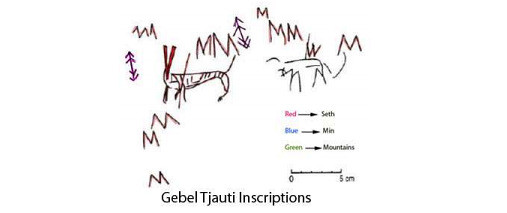
― SETH AND THE ENVIRONMENT
( Maria Jose Amor Martinez )
Keep reading
153 notes
·
View notes
Text

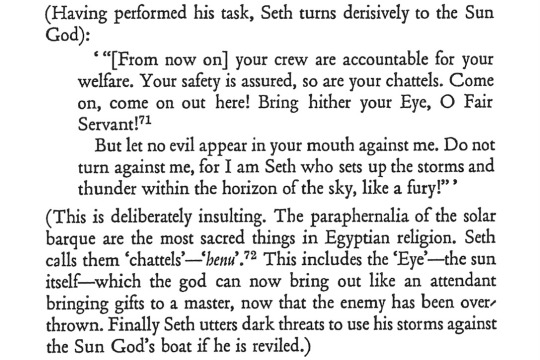
- ”Myth and Symbol in Ancient Egypt”. R.T Rundle Clark
138 notes
·
View notes
Text

Finally got some scars to go with my tats. It hurt but not a ton.
104 notes
·
View notes
Text
In european occult studies, people tend to throw around the word Kabbalah as a general word for an esoteric study. Many occultists will refer to the Islamic Kabbalah or the Hermetic Kabbalah, despite these things having nothing to do with the actual Jewish Kabbalah.
"I wonder if there are any alternative terms?" I think to myself. "I know Fulcanelli writes about alchemical history a lot, I bet he can give me historical examples of less problematic terms!"
Fulcanelli:

2K notes
·
View notes
Note
can you explain how/why lemuria became an occult thing because im sorry but it's so funny to me that the name a hypothetical place a palaeontplig8st thought up to explain why there were lemur fossils on different continents before people knew about continental drift is being slapped on healing crystals or whatever
Fucking Blavatsky
4K notes
·
View notes
Text
I feel now is a good time to recognize and admit that Set can be and is a phallic god at times. That is all.
0 notes
Photo
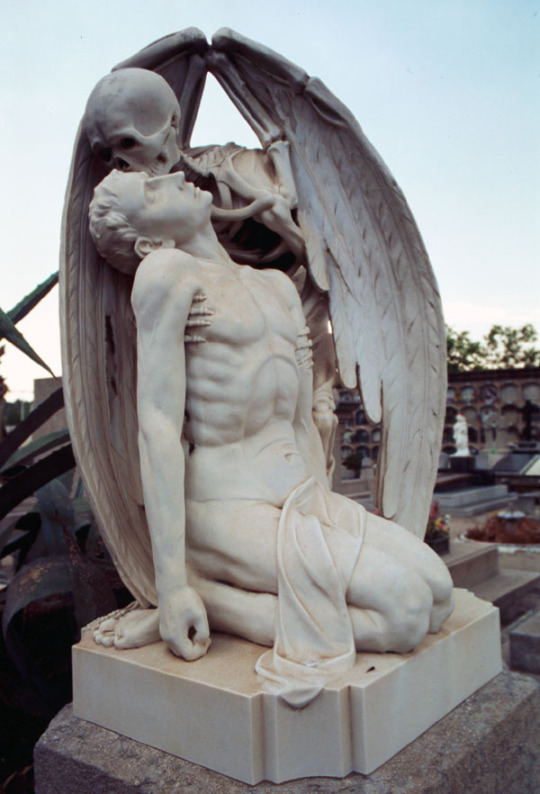
The Kiss of Death (El petó de la mort), Poblenou Cemetery in Barcelona.
18K notes
·
View notes
Text
Jumblr these days seems to have a big issue with goyische witches/pagans appropriating Kabbalistic practices and beliefs. And it is something people need to learn is not okay. I also think there’s a distinct lack of pointing out that even Jews are restricted on learning about it until they’re 40 or have a solid grasp on Torah and Talmud. Like even the people it belongs to are kept from learning it until they have a deep understanding of its foundations, what on EARTH makes tumblr witches think it’s okay for them to claim it as their own
172 notes
·
View notes
Text
Old forgotten draft prayer:
Children of Ash, children of smoldering fires
We found our peace in each other
The olive branches woven with love wrapped around us never fully wither
We have all branched off now in the frigid cold, we weep for the green we feel we are devoid of now
Two glimmers catch each other's eyes once again, reminding each other of the deep sap we come from
The outspoken children, the shameless children, the hurt children. The loving children, the hopeful and hopeless children, the adventurous and gleeful children. The rejected children, the sneaky children, the surviving children.
We feel our woahs, we have sympathy pains of each other's hungers. We feed each other what we can spare, we protect what life we have of each other.
We feel our love, complicated but honest. We bond over our poisons and share our water. We take care of ourselves and look out for each other.
What has fallen apart is not dead. We will live on. We may not be bound as tight, but what was there can never disappear.
We wink to each other when we brush paths and smile for the love of it. The love of the golden days will be shared in those brief moments.
The love is not gone, it is only spread out. We were not who we thought we were then, but we knew each other well.
Let what sprouted for all of us grow into the world, a hearty oak that'll spread a forest of love. The Wesley kids know love, and may we take it everywhere we go.
The spirit of the taboo children lives on, may we pass it below us and push through above us.
I ask that the spirit of our roots to be recognized for what it is, a powerful force we should all be able to tap into for those of us who share it.
May it be apart of our instinct and our lessons, may we all grow for having known each other.
May it be a standing force of it's own, powerful and beautiful.
The children of the Ash are never to be forgotten, we lay our blackened handprints on the wall. "We are here." It is our message to the children coming to take our place, and the former children who passed it to us.
The Hopelessly Hopeful children take pride in who they are and where they come from. We all build a better tomorrow that welcomes us.
#a recently discovered old draft#i know what its about but not why#its some kind of prayer#and as pretty and romantic as it is#it feels poorly constructed with no focused point#spell work#in the drafts#witchcraft#i do feel strongly about it tho#pagan prayer#occult
4 notes
·
View notes
Photo

To help with all magical work from The British Book of Spells and charms by Graham King #bookofshadows #bookofspells #thebritishbookofspellsandcharms #witchcraft
614 notes
·
View notes
